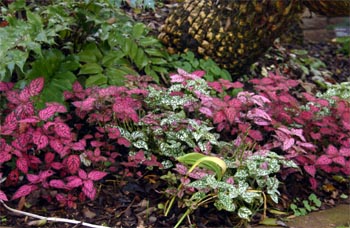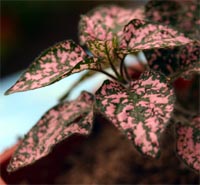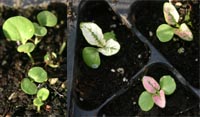
Polka dot plant (Hypoestes phyllostachya) is a delicate tropical foliage plant once relegated to the role of novelty houseplant. It has gained more popularity as an annual outdoors, brightening borders and adding to container plantings. Originally the only type available had pink spots covering the small, dark green foliage, but today many other hybrids are available with splashes of bright red, white, or lighter green, or even the reverse of pink with green spots. Stems and branches may also be colored. This plant does produce terminal, spike-like racemes of small, tubular pink or blue flowers, but they are not particularly showy. Long day lengths keep the plants in vegetative growth, so flowering occurs in late summer or fall, if at all on houseplants. In warm season areas the plants reseed freely.

H. phyllostachya (Family Acanthceae) is native to Madagascar; other species in the genus come from South Africa and Southeast Asia. Polka dot plant is a bushy plant with oval, softly downy leaves. Under ideal conditions the species grows up to 30 inches high and wide; many cultivars remain much smaller than this.
In addition to being an indoor houseplant, Hypoestes can be used as an accent plant in dish gardens, window boxes or patio containers or can be grown as a bedding plant to add some color in partially shaded areas. They combine nicely with impatiens, New Guinea impatiens or caladiums.
Hypoestes grows best in bright, filtered light, but tolerates some sun. The plants have better color in partial shade than full sun, but the leaves also fade out in very low light. It prefers a humid environment, so should be quite happy outdoors in the Midwest in summer, but may need periodic misting indoors during the winter. Although it is somewhat drought tolerant, it does grow better with plenty of water.

Sow Hypoestes seed 8-10 weeks before the average last date of frost for plants intended for the garden. (Sow anytime for houseplants.) Seeds will germinate as quickly as 4 days when held at 68°F.

The cotyledons of are green, but the first set of true leaves are colored. Seedlings should be transplanted when they have four true leaves, individually into small pots or several together in larger containers. Three seedlings can be planted in a 3-inch pot and five per 4-inch pot. Use potting mixes high in organic matter such as peat moss or leaf mold. Wait until temperatures are consistently above 50°F to plant outdoors; it doesn’t grow well until temperatures are over 60°F
Hypoestes has few pest problems, but is susceptible to powdery mildew and root rot, and may become infested with whiteflies, aphids, and mealybugs.

Polka dot plants will get leggy as they age, particularly in lower than ideal light. Regular pinching back will keep the plants more compact, but eventually houseplants will need to be replaced. Stem cuttings are easily rooted to create new plants. They quickly produce roots when placed in water and they often will grow when just stuck into moist potting mix, sand or vermiculite, especially in spring and summer. Take cuttings 4 inches long and remove the lower leaves. Polka dot plants can also be saved over the winter by potting up plants from the garden in late summer and keeping them in a bright window.

To grow as a house or greenhouse plant, use a porous soil mix high in organic matter. Place the potted plant in a location that receives bright light and water well when they are growing actively, allowing the soil to dry slightly between waterings. Once established, plants should be fertilized periodically with dilute liquid fertilizer. They can also be grown under artificial light.
Some cultivars that may be available include:
- ‘Carmina’ has bright red splotches on the leaves.
- ‘Confetti’ series plants are smaller (8 inches) but more vigorous growers than other cultivars, so they fill in more quickly in the landscape. The five separate colors include white, pink, red, carmine rose and burgundy red; they are often offered together as a mix.
- ‘Pink Brocade’ is mottled with pink spots.
- ‘Pink Dot’ has attractive pink spots.
- ‘Purpuriana’ has purplish leaves.
- ‘Splash’ series has large blotches of contrasting color in pink, red, rose or white.
- ‘Wit’ offers marbled white leaves.
– Susan Mahr, University of Wisconsin – Madison





 Marigolds
Marigolds Create a Butterfly Garden
Create a Butterfly Garden Plant Flowers to Encourage Beneficial Insects
Plant Flowers to Encourage Beneficial Insects Forcing Bulbs
Forcing Bulbs


